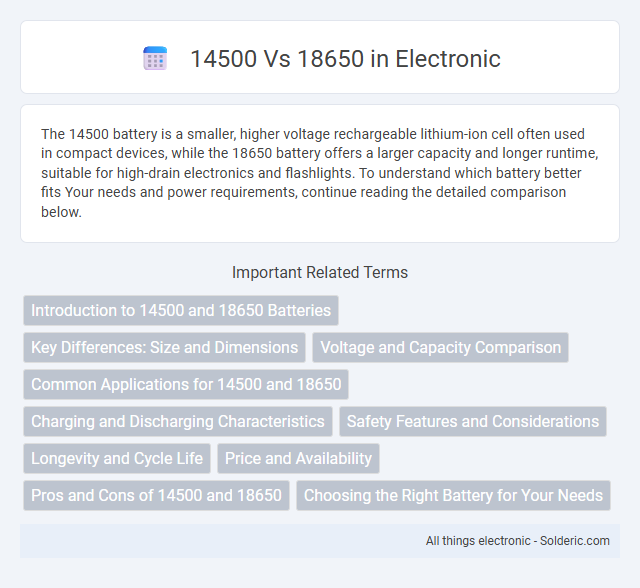The 14500 battery is a smaller, higher voltage rechargeable lithium-ion cell often used in compact devices, while the 18650 battery offers a larger capacity and longer runtime, suitable for high-drain electronics and flashlights. To understand which battery better fits Your needs and power requirements, continue reading the detailed comparison below.
Comparison Table
| Feature | 14500 Battery | 18650 Battery |
|---|---|---|
| Size | 14mm diameter x 50mm length | 18mm diameter x 65mm length |
| Capacity | 600-1000mAh | 1800-3500mAh |
| Voltage | 3.7V (Li-ion) | 3.7V (Li-ion) |
| Common Use | Small devices, flashlights, cameras | Laptops, high-drain devices, flashlights |
| Weight | Approx. 20-25g | Approx. 40-50g |
| Rechargeable | Yes | Yes |
| Price | Lower | Higher |
Introduction to 14500 and 18650 Batteries
14500 and 18650 batteries are both lithium-ion rechargeable cells commonly used in portable electronics, with the 14500 measuring 14mm in diameter and 50mm in length, while the 18650 is 18mm by 65mm. The 18650 offers higher capacity, typically between 2000mAh to 3500mAh, compared to the 14500's approximate 600mAh to 850mAh, making it suitable for devices with greater power needs. Both batteries maintain a nominal voltage of 3.7 volts but differ significantly in size, energy density, and typical application.
Key Differences: Size and Dimensions
14500 batteries measure approximately 14mm in diameter and 50mm in length, making them similar in size to AA batteries, while 18650 batteries are larger with dimensions of about 18mm in diameter and 65mm in length. The size difference significantly affects their capacity and compatibility with devices, as 18650 cells generally offer higher energy storage and power output. When choosing a battery for your device, consider these dimensional disparities to ensure proper fit and optimal performance.
Voltage and Capacity Comparison
The 14500 battery typically has a nominal voltage of 3.7 volts and a capacity ranging from 600 to 1,200 mAh, while the 18650 battery also maintains a nominal voltage of 3.7 volts but offers significantly higher capacities between 1,800 and 3,500 mAh. Both batteries share the same voltage, making them interchangeable in voltage-sensitive applications; however, the 18650 provides longer run times and better energy storage due to its larger physical size and higher capacity. Devices requiring extended battery life or higher power output generally benefit from using 18650 cells over 14500 cells.
Common Applications for 14500 and 18650
14500 batteries are commonly used in smaller devices like flashlights, laser pointers, and portable electronics due to their compact size similar to AA batteries. 18650 batteries, with higher capacity and power output, are preferred in laptops, electric vehicles, high-performance flashlights, and power tools. Your choice depends on the device's size constraints and energy requirements, with 14500 offering portability and 18650 providing longer battery life and greater power.
Charging and Discharging Characteristics
14500 and 18650 lithium-ion batteries differ significantly in charging and discharging characteristics, with the 18650 typically offering higher capacity, allowing for longer discharge times at consistent voltages. The 14500's smaller size results in lower mAh ratings, which affects its ability to sustain high-current discharges compared to the more robust 18650 cells. Charging protocols for both batteries require regulated current and voltage inputs, but the 18650 generally supports faster charging rates due to better thermal management and higher maximum charge currents.
Safety Features and Considerations
14500 lithium-ion batteries typically have lower capacity and size, which can contribute to enhanced thermal management and reduced risk of overheating compared to larger 18650 cells. 18650 batteries often incorporate advanced safety features such as pressure relief vents, PTC (Positive Temperature Coefficient) switches, and built-in current interrupt devices to prevent thermal runaway and short circuits. Proper usage, storage, and avoiding overcharging or deep discharging are critical safety considerations for both battery types to ensure optimal performance and longevity.
Longevity and Cycle Life
The 18650 lithium-ion battery typically offers a longer cycle life, ranging from 300 to 500 full charge-discharge cycles, whereas the 14500 usually supports around 300 cycles. Due to its larger size and capacity, the 18650 experiences less strain during use, enhancing its longevity compared to the smaller 14500 battery. Choosing the 18650 extends overall device runtime and reduces the frequency of replacements in high-drain applications.
Price and Availability
The 14500 battery is generally more affordable and easier to find due to its compatibility with standard AA battery size, making it widely available in retail stores. The 18650 battery, while slightly more expensive, offers higher capacity and is commonly available through specialized electronics suppliers and online retailers. Both types benefit from strong market presence, but 18650 cells often come in a broader range of performance options and brands.
Pros and Cons of 14500 and 18650
14500 batteries are compact, making them ideal for smaller devices and offering portability advantages over the larger 18650 cells. However, 18650 batteries provide higher capacity and longer battery life, suitable for high-drain electronics and extended use. Your choice depends on device size constraints and power needs, balancing 14500's size benefits against 18650's superior energy density.
Choosing the Right Battery for Your Needs
Selecting between a 14500 and 18650 battery depends on your device's energy requirements and size constraints. The 14500 battery offers a compact form factor with a typical capacity around 800-1100mAh and a voltage of 3.7V, making it ideal for smaller electronics like flashlights or vaporizers. In contrast, the 18650 battery provides higher capacity, usually 2500-3500mAh, and longer runtime, suited for high-drain devices such as laptops, power tools, and electric vehicles.
14500 vs 18650 Infographic

 solderic.com
solderic.com